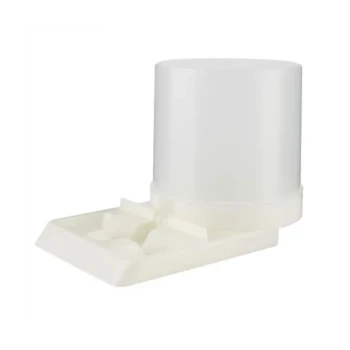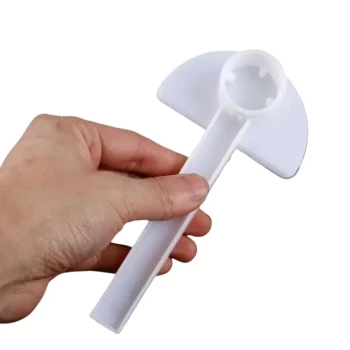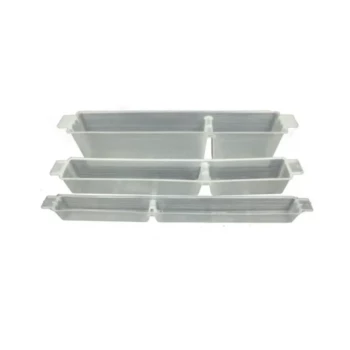The four basic styles of bee feeders are Entrance Feeders, Top Feeders, Frame Feeders, and Pail Feeders. While other variations exist, these four categories represent the primary methods beekeepers use to provide supplemental nutrition to a colony. Each is designed for a different purpose, balancing convenience, capacity, and impact on the hive.
The most important thing to understand is that no single feeder is "best." The right choice depends entirely on your specific goal—whether you are stimulating spring growth, providing emergency food, or rapidly building winter stores—and the unique conditions of your hive and climate.
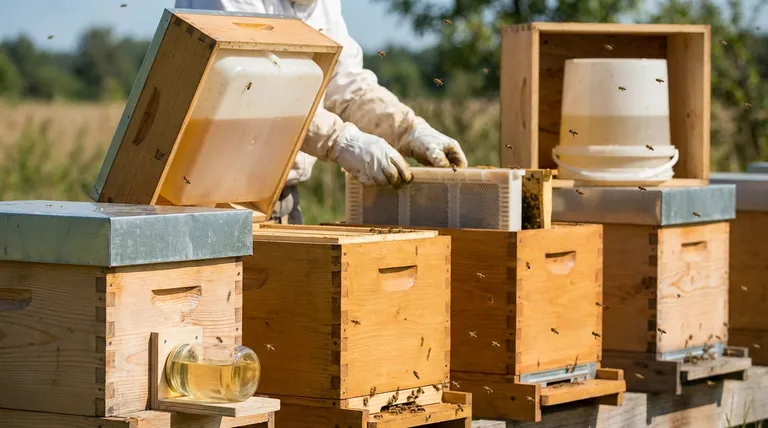
1. Entrance Feeders
Entrance feeders, often called Boardman feeders, are one of the most common types, especially for new beekeepers.
How They Work
This feeder consists of a small tray that slides into the hive entrance. An inverted jar (typically a standard Mason jar) filled with syrup is placed onto the tray, allowing a small amount of liquid to fill the feeding area.
Primary Use Case
They are best for providing a slow, steady supply of syrup to a small or new colony. This slow "drip" mimics a light nectar flow, which can stimulate the queen to lay eggs.
Key Advantage
The primary benefit is convenience. You can monitor the syrup level and refill the jar without opening the hive, minimizing disturbance to the colony.
Significant Drawback
Entrance feeders are highly prone to attracting robber bees from other hives and pests like wasps. Because the food source is outside the hive, it can incite robbing behavior that can decimate a weak colony.
2. Top Feeders
Top feeders are high-capacity feeders placed on top of the uppermost hive box, directly under the outer cover.
How They Work
They come in various styles. Some are large, open reservoirs where bees climb up from the hive body to access a large surface area of syrup. Others function more like pail feeders, where bees access the syrup from a protected, mesh-covered opening from below.
Primary Use Case
These are used for rapid feeding, such as helping a colony build up its honey stores quickly before winter. Their large volume means you can deliver a gallon or more of syrup at once.
Key Advantage
They hold a large quantity of feed and are contained within the hive, which significantly reduces the risk of robbing.
Significant Drawback
In open-style models, bees can easily fall into the syrup and drown. It is critical to provide floats (like wood chips, hardware cloth, or plastic floats) for the bees to stand on.
3. Frame Feeders
Also known as division board feeders, these are designed to fit inside the hive body in place of one or more frames.
How They Work
A frame feeder is essentially a thin, plastic tank with the same dimensions as a standard hive frame. You fill it with syrup, and bees access it from inside the hive cluster.
Primary Use Case
Frame feeders are excellent for feeding new packages or weaker hives, as the food is located very close to the brood nest. This prevents the bees from having to break cluster to feed in cold weather.
Key Advantage
Placing the feed inside the hive and next to the bees offers maximum protection from robbing and ensures even a small cluster can access it easily.
Significant Drawback
These feeders take up space where bees could be drawing comb. They also require you to open the hive to refill, and bees can drown if the feeder does not have integrated ladders or floats.
4. Pail Feeders
A pail feeder is a simple, effective, and very popular style of top feeder.
How They Work
This method involves a standard plastic pail with a tight-fitting lid. You drill very small holes (1/16 inch) in the center of the lid, fill the pail with syrup, and invert it over the inner cover's central hole. A spare hive body is placed around the pail to protect it.
Primary Use Case
Like other top feeders, pail feeders are ideal for delivering large amounts of food with minimal risk of robbing.
Key Advantage
They are extremely safe for bees. The vacuum pressure inside the pail prevents the syrup from dripping, so bees simply drink from the holes. This design makes it nearly impossible for bees to drown.
Significant Drawback
They can be slow to set up initially and require a spare, empty hive box to enclose the feeder and protect it from the elements and pests.
Understanding the Critical Trade-offs
Choosing a feeder involves balancing competing priorities for the health and safety of your colony.
Robbing vs. Hive Intrusion
External feeders like the entrance feeder are easy to refill but dramatically increase the risk of robbing. Internal feeders like the frame feeder are secure from robbers but require you to open the hive, which can chill the brood and disturb the colony.
Speed of Delivery
A top or pail feeder delivers a large volume of syrup quickly, which is ideal for "panic feeding" or building winter stores. An entrance or frame feeder provides a slower, more sustained source that is better for stimulating brood production without overwhelming the hive's storage space.
Drowning Risk
Any open reservoir of liquid, such as in some top feeders and many frame feeders, poses a drowning risk. Pail feeders and entrance feeders almost entirely eliminate this danger.
Honey Adulteration
Never feed sugar syrup when honey supers are on the hive. If bees store sugar syrup in the comb you intend to harvest, it will adulterate the honey, and it can no longer be legally or ethically sold or labeled as pure honey.
Making the Right Choice for Your Goal
Select your feeder based on what you need to accomplish for your bees.
- If your primary focus is stimulating a new or small colony in spring: Use an entrance feeder or a frame feeder to provide a slow, steady food source.
- If your primary focus is rapidly building winter stores in the fall: Use a high-capacity top feeder or pail feeder to deliver large volumes of syrup quickly and safely.
- If your primary focus is providing emergency food during cold weather: Use a frame feeder to ensure the food is inside the hive, right next to the cluster.
- If your primary focus is minimizing all risk of robbing: Use an internal option like a frame, top, or pail feeder. Avoid entrance feeders entirely.
Understanding how each feeder works empowers you to provide the right support for your bees at the right time.
Summary Table:
| Feeder Type | Primary Use Case | Key Advantage | Significant Drawback |
|---|---|---|---|
| Entrance Feeder | Stimulating spring growth in small/new colonies | Easy to refill without opening the hive | High risk of attracting robber bees |
| Top Feeder | Rapidly building winter stores | Large capacity; reduces robbing risk | Drowning risk for bees without floats |
| Frame Feeder | Feeding new packages or weak/cold hives | Food is inside hive, close to brood nest | Takes up space where bees could draw comb |
| Pail Feeder | Safe, high-volume feeding with minimal robbing | Extremely safe; minimal drowning risk | Requires a spare hive body for setup |
Equip Your Apiary with the Right Feeders from HONESTBEE
Choosing the correct feeder is critical for colony health and honey production. As a leading wholesale supplier, HONESTBEE provides commercial apiaries and beekeeping equipment distributors with durable, high-performance feeders tailored for large-scale operations. We help you manage your hives more efficiently and profitably.
Ready to stock up on the right equipment for your beekeeping goals? Contact our wholesale team today to discuss your needs and get a quote.
Visual Guide
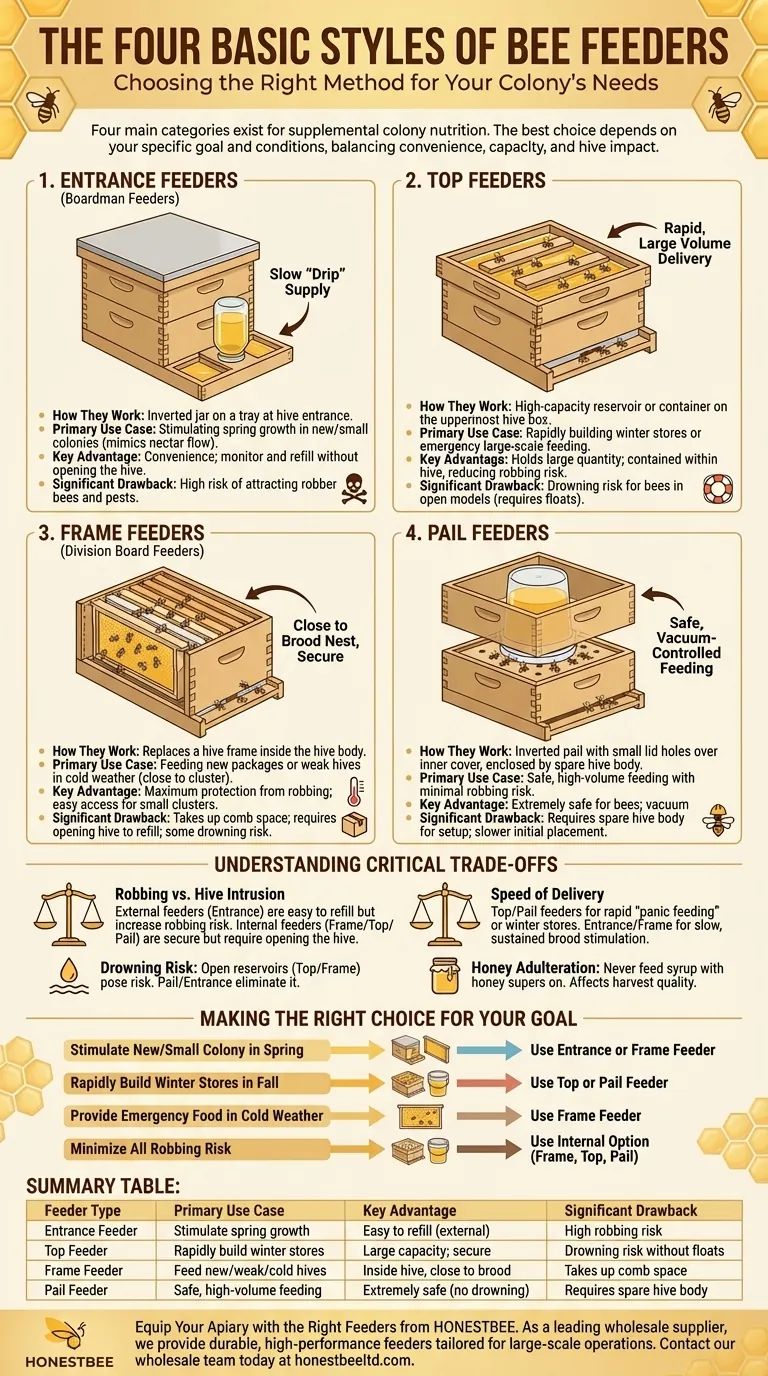
Related Products
- Classic Boardman Entrance Bee Feeder Hive Front Feeding Solution
- HONESTBEE Entrance Bee Feeder Professional Hive Nutrition Solution for Beekeeping
- HONESTBEE Professional Entrance Bee Feeder Hive Nutrition Solution
- Boardman Entrance Bee Feeder Durable Galvanized Steel and Wood Construction for Beekeeping
- Professional In-Hive Frame Bee Feeder by HONESTBEE
People Also Ask
- What is a common problem with hive front feeders? Avoid Robbing Frenzies and Protect Your Hives
- How is the mesh ladder and barrier installed in the feeder box? A Step-by-Step Guide to Prevent Bee Drowning
- How to make an entrance feeder for bees? A DIY Guide for Safe & Effective Feeding
- Should bees be fed after installing a nucleus hive? Ensure Your New Colony Thrives
- How can a Boardman Feeder be used to provide water to bees? Avoid These Critical Risks to Your Hive

